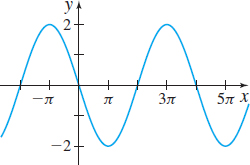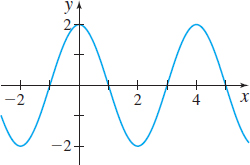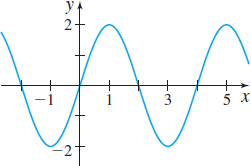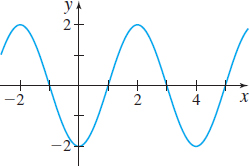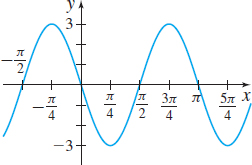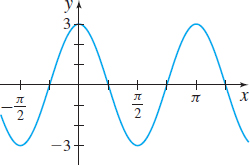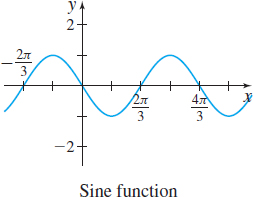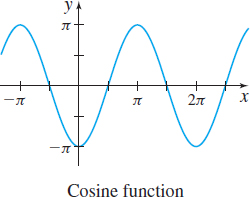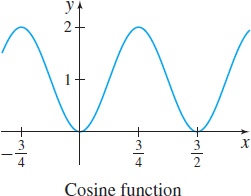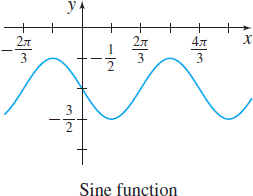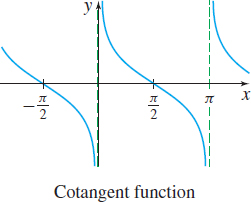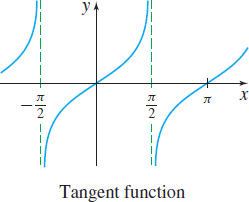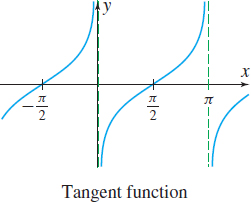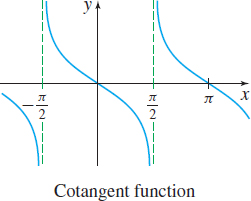P.6 Assess Your UnderstandingPrinted Page 56
Concepts and Vocabulary
The sine, cosine, cosecant, and secant functions have period _____; the tangent and cotangent functions have period _____.
\(2\pi\), \(\pi\)
The domain of the tangent function \(f( x) = \tan x\) is _____.
All real numbers except odd multiples of \(\frac{\pi}{2}\)
The range of the sine function \(f( x) = \sin x\) is _____.
\(\{y | -1 \le y \le 1\}\)
Explain why \(\tan\! \left(\! \dfrac{\pi }{4}+2\pi \right) =\tan \dfrac{\pi }{4}\).
The period of \(\tan x\) is \(\pi\).
True or False The range of the secant function is the set of all positive real numbers.
False
The function \(f( x) = 3\cos (6x)\) has amplitude _____ and period _____.
\(3\), \(\frac{\pi}{3}\)
True or False The graphs of \(y=\sin x\) and \(y=\cos x\) are identical except for a horizontal shift.
True
True or False The amplitude of the function \(f( x) =2\sin ( \pi x)\) is \(2\) and its period is \(\dfrac{\pi }{2}\).
False
True or False The graph of the sine function has infinitely many \(x\)-intercepts.
True
The graph of \(y=\tan x\) is symmetric with respect to the _____.
Origin
The graph of \(y=\sec x\) is symmetric with respect to the _____.
\(y\)-axis
Explain, in your own words, what it means for a function to be periodic.
Answers will vary.
Practice Problems
In Problems 13–16, use the even-odd properties to find the exact value of each expression.
\(\tan\! \left(\! -\dfrac{\pi }{4} \right)\)
\(-1\)
\(\sin\! \left(\!\! -\dfrac{3\pi }{2}\! \right)\)
\(\csc\! \left(\! -\dfrac{\pi }{3} \right)\)
\(-\frac{2\sqrt{3}}{3}\)
\(\cos\! \left(\! -\dfrac{\pi }{6} \right)\)
57
In Problems 17–20, if necessary, refer to a graph to answer each question.
What is the \(y\)-intercept of \({f}( x) =\tan x\)?
\(0\)
Find the \(x\)-intercepts of \(f( x) =\sin x\) on the interval \([-2\pi ,2\pi]\).
What is the smallest value of \(f(x) =\cos x\)?
\(-1\)
For what numbers \(x\), \(-2\pi \leq x\leq 2\pi\), does \(\sin x=1\)? Where in the interval \([ -2\pi ,2\pi]\) does \(\sin x=-1\)?
In Problems 21–26, the graphs of six trigonometric functions are given. Match each graph to one of the following functions:
- (a) \(y=2\sin\! \left( \dfrac{\pi }{2}x\right)\)
- (b) \(y=2\cos\! \left( \dfrac{\pi }{2}x\right)\)
- (c) \(y=3\cos ( 2x)\)
- (d) \(y=-3\sin ( 2x)\)
- (e) \(y=-2\cos\! \left( \dfrac{\pi }{2}x\right)\)
- (f) \(y=-2\sin\! \left( \dfrac{1}{2}x\right)\)
(f)
(a)
(d)
In Problems 27–32, graph each function using transformations. Be sure to label key points and show at least two periods.
\(f( x) =4\sin (\pi x)\)
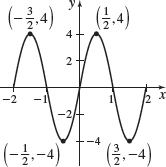
\(f( x) =-3\cos x\)
\(f( x) =3\cos ( 2x) -4\)
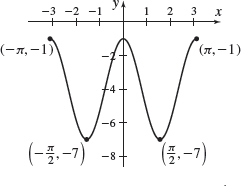
\(f( x) =4\sin ( 2x) +2\)
\(f( x) =\tan\! \left( \dfrac{\pi }{2}x\! \right) \)
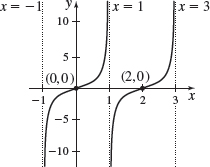
\(f( x) =4\sec\! \left( \dfrac{1}{2}x\! \right)\)
In Problems 33–36, determine the amplitude and period of each function.
\(g( x) =\dfrac{1}{2}\cos ( \pi x)\)
\(\frac{1}{2}\), \(2\)
\(f( x) =\sin ( 2x)\)
\(g( x) =3\sin x\)
\(3\), \(2\pi\)
\(f( x) =-2\cos\! \left( \dfrac{3}{2}x\!\right)\)
In Problems 37 and 38, write the sine function that has the given properties.
Amplitude: 2, Period: \(\pi\)
\(f(x)=2\sin(2x)\)
Amplitude: \(\dfrac{1}{3}\), Period: 2
In Problems 39 and 40, write the cosine function that has the given properties.
Amplitude: \(\dfrac{1}{2}\), Period: \(\pi\)
\(f(x)=\frac{1}{2}\cos(2x)\)
Amplitude: \(3\), Period: \(4\pi\)
In Problems 41–48, for each graph, find an equation involving the indicated trigonometric function.
\(f(x) = -\sin\left(\frac{3}{2}x\right)\)
\(f(x) = 1-\cos\left(\frac{4\pi}{3}x\right)\)
\(f(x) = \cot x\)
\(f(x) = \tan\left(x-\frac{\pi}{2}\right)\)

